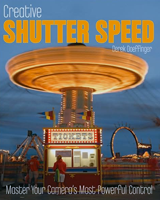
Creative Shutter Speed
By Derek Doeffinger
Wiley Publishing, Inc.
ISBN: 978-0-470-45362-9
US $24.99, CDN $29.99
256 pages
Creative Shutter Speed, by Derek Doeffinger, is a clear and informative primer for any amateur photographer who wants to move beyond a camera’s automatic settings. The auto setting on better Digital Single Lens Reflex DSLRs (see link below) is so good that it’s easy to overlook the fact that they aren’t perfect and that, with a little tweaking, the image can be significantly improved. The author makes this point convincingly, and without ever disparaging those who just want to point and shoot.
The best thing about Doeffinger’s book is that, without any gimmicky prose, it guides you from concept to practice. And since it’s really not useful to discuss shutter speed without delving into other factors that contribute to making a satisfying exposure, the book is really an introduction to everything that goes into good picture-taking.
However, the focus (no pun intended) of the book is shutter speed, and it’s organized so that practical information is immediately accessible in the opening chapter, Tap the Power of Every Shutter Speed. Someone else might have chosen to use Chapter 2, Understanding Shutter Speed and Exposure, as the book’s opening. Certainly that would seem logical, but readers will quickly find that the editors made the right choice by leaving the more in-depth discussion for the second chapter.
Why? Because Chapter 1, Tap the Power of Every Shutter Speed, lists every shutter speed you’ll ever encounter and briefly lets you know what it can (and sometimes cannot) be used for. This enables the reader to pick up his or her camera, set the dial to Shutter Priority, and immediately begin experimenting. If, like me, you like to tinker, this can be great fun, and very enlightening.
For example, place your camera on a tripod and aim it at anything in your house: a lamp, a vase, whatever catches your eye. Turn the camera’s mode button to Shutter Priority and rotate the appropriate button to 1/2 second. Take a picture. In the next frame, rotate the dial to 1/4 or 1/8. After you’ve played with this for a few minutes, set the camera to Auto and take the same picture. More than likely, you’ll see a radical difference between the slower shutter speeds and what the camera selected using the Auto setting. You’ll be very surprised.
For experienced photographers, this kind of information is obvious. For beginners, however, this is an important and entertaining lesson, and Doeffinger makes it easily available by not assuming that we know more than we actually do. His voice is that of a helpful friend. Readers won’t have to wade through the morass of a bloated ego to arrive at the information they’re seeking.
His language is direct and his information is presented with real life examples. Technical jargon is kept to a minimum and when he addresses a term you may not be familiar with, such as a histogram, the text is clarified with good illustrations. A histogram is a graph that shows how light and dark tones are distributed in a photo. Doeffinger helpfully shows both a histogram and the photo it represents, explaining how the light in different parts of the photo is expressed in the image on the histogram graph.
In short, if you want to learn how to get better pictures with a digital camera, or if you know someone whose imagination has suddenly been ignited by the possibilities of picture-taking art, this book would make an excellent holiday gift.
email – MyMac Magazine – Twitter – Advertise – Reviews Archive – Podcast

Leave a Reply
You must be logged in to post a comment.